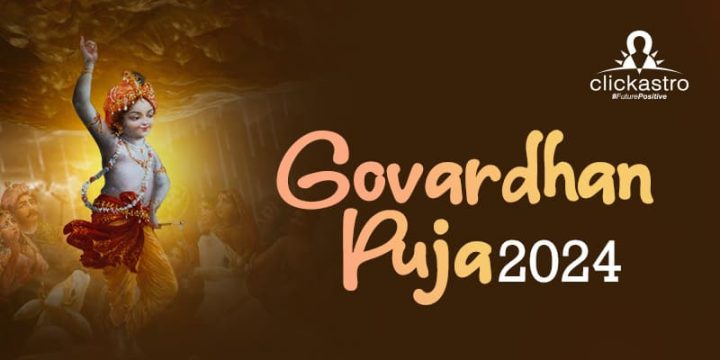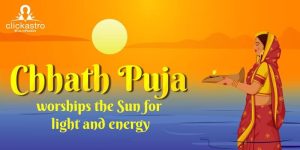Govardhan Puja is a
Hindu festival dedicated to Lord Krishna. The devotees on this day offer a large variety of vegetarian food to Krishna and worship the Govardhan Hill. The festival is also known as Annakut, which means a mountain of food. Devotees offer a mountain of food, arranging the food items in tiers or steps. This metaphorically represents Govardhan Hill. The ritual is observed as a mark of gratitude and renews the faith in taking refuge in Lord Krishna.
Govardhan Puja 2024 is on November 2, Saturday.
The Govardhan Puja or Annakut festival occurs on the first lunar day (Ekam) of the
Shukla Paksha (bright fortnight) in the month of Kartik, which is usually the day after
Diwali – the festival of lights.
The day will be celebrated as the occasion where Lord Krishna defeated Indra. It marked the legend in the Bhagavata Purana when Krishna lifted the Govardhan Hill to protect the people of Vrindavan from torrential rains created by Indra. Thus, the Govardhan Puja festival is a remembrance of how god will protect the devotees who take singular refuge in him. It is one of the important festivals for the Vaishnava cults.
Govardhan Puja 2024 Date & Important Timings
- Govardhan Puja Pratahkala Muhurat : November 02, 06:36 AM – 08:50 AM
- Duration – 02 Hours 14 Mins
- Govardhan Puja Sayankala Muhurat : November 02, 03:30 PM – 05:44 PM
- Duration – 02 Hours 14 Mins
- Pratipada Tithi Begins : November 01, 06:17 PM
- Pratipada Tithi Ends : November 02, 08:22 PM
- Sunrise : November 02, 6:36 AM
- Sunset : November 02, 5:44 PM
Govardhan Puja and Diwali
Govardhan Puja or Annakut Puja is also known by the names Bali Pratipada, Padwa etc. The festival also coincides with the New Year day of Gujarat and the Haryana regions.

Most of the time, Govardhan Puja falls the day after the main Diwali in the month of Kartik. Diwali, in the northern regions of India, is a five-day-long festival extending from the Krishna Paksha Thrayodashi (13th lunar day in the dark fortnight) of the Ashwin month to the Shukla Paksha Dwitiya (2nd lunar day in the bright fortnight) of the Kartik month.
Amavasya (new moon) marking the end of Ashwin month, is the main Diwali day. So, Govardhan Puja or Annakut is observed on the fourth day of the 5-day grand Diwali festival. The Govardhan Puja rituals are linked to the rituals of the five days of Diwali. While the rituals of the first three days of Diwali are symbolic of inviting greater wealth and prosperity, the Annakut day is dedicated to offering gratitude for Krishna’s beneficence.
Some religious texts suggest Govardhan Puja celebrations on the Pratipada
Tithi of Kartik month. Occasionally, depending on the lunar cycles, there can be a day gap between Diwali and Govardhan Puja celebrations.
What does 2024 look like for you, find out
Govardhan Puja Rituals & Celebrations
The rituals associated with Govardhan Puja vary according to different regions and different sects in Hinduism. It is celebrated with great enthusiasm in the states of Haryana, Punjab, Bihar and Uttar Pradesh.
The preparation of Annakut (mountain of food) is an integral part of the Govardhan Puja festival. Devotees prepare a large variety of vegetarian food using wheat, rice, curry of gram flour and leafy vegetables and offer them to Lord Krishna. They arrange a wide variety of vegetarian foods in tiers or steps in front of the deity. The sweets are placed nearest to the deity, and as the tiers descend, other foods such as dal, vegetables, pulses and fried savoury are arranged. A mound of cooked grains representing Mount Govardhan is placed in the centre.
The devotees may prepare 108 or 56 varieties of food and offer them as Bhog to the deity. The Govardhan or Annakut Puja includes bathing the Krishna idols with milk, adorning them with dazzling clothes and jewellery, and worshipping in the traditional way with Bhog and Aarti. After the Puja, the Annakut Prasad is distributed.
Bochasanwasi Akshar Purushottam Swaminarayan Sanstha (BAPS) – the Hindu denomination within the Swaminarayan Sampradaya celebrates Annakut at approximately 3,850 BAPS temples and centres throughout the world. It is often the largest festival of the year in these temples. The visitors to the BAPS temples spread across the world learn about Hindu spirituality, offer prayers and engage in other devotional activities. These gatherings also provide a platform for reaffirming the sense of community. The Annakut with over 3500 vegetarian dishes organised in BAPS Atladra Mandir in Gujarat in 2019 holds the Guinness World record for the largest Annakut ever held.
Singing Thaal (Kirtans or devotional hymns composed by the poet Paramhansas of Swaminarayan) is a common Govardhan Puja festival observance in Swaminarayan temples. These Kirtans are about praying to the deity to accept the different food items.
Mount Govardhan in the Mathura district of Uttar Pradesh is a major pilgrimage site for the devotees of Krishna. On the day of Annakut, lakhs of devotees visit Mount Govardhan and circumambulate the mountain to seek the blessings of the lord. This circumambulation consists of an eleven-mile trek during which the devotees visit the shrines on the way and make their offerings.
The celebrations of Govardhan Puja in Nathdwara, Mathura and Vrindavan are very notable. In the temples here, the deities are given a milk bath before being adorned in elegant clothes and ornaments. Special prayers are organised here, and devotees flock to these places in large numbers. Annakut prasad is distributed to everyone who visits these temples on this day.
Making cow dung hillocks that are symbolic of Mount Govardhan is a ritual followed in some areas, particularly in the state of Haryana. This involves making a model of Mount Govardhan using cow dung and decorating it with flowers. Govardhan Giri or Mount Govardhan is worshipped as a god in its own right on this day. So, the devotees worship the Mount Govardhan replica made of cow dung, performing Puja and Parikarma (the ritualistic circumambulation). They worship the cow dung hillocks using a clay lamp, incense sticks, kumkum, fruits, honey, curd, milk, Ganga Jal etc. The Puja is performed in the early morning or in the evening. While performing the Parikarma, devotees hail God Govardhan and pray to protect them from the hardships of life. The animals that help them in agriculture are also honoured on this day. They give baths to their cattle and decorate them with garlands and saffron.
Bali Pratipada or Bali Padva is the name by which this day is observed in Maharashtra. This festival commemorates the victory of Vamana (an incarnation of Vishnu) over King Bali and the return of Bali to visit his land and people. The belief is that Vamana has given Bali the boon to visit Prithvi Lok (Earth) from the Patal Lok (netherworld) on this day. For the people of Maharashtra, this is an occasion for celebrating selfless love and devotion between husband and wife. Wife performing Aarti on husband and husband offering gifts in return is a common Bali Padva ritual followed here. Bali Padyami and Kartik Shudha Padwa are some other names of this festival.
Vishwakarma Day is observed on this occasion (the day after Diwali) in some states of India. Lord Vishwakarma is the god of skilled craftspeople, and devotees dedicate this occasion to worshipping tools and implements, including industrial machinery.
Annakut or Govardhan Puja, for some believers, is also an occasion for transmitting religious and cultural values to children. In the states of Haryana and Gujarat, Govardhan Puja coincides with their New Year day. Gujarati New Year day is celebrated on the Shukla Paksha Pratipada of Kartik month. Occasionally, depending on the starting time of Pratipada Tithi, Govardhan Puja celebrations are observed one day before Gujarati New Year day.
The mythology of Govardhan Puja
The most common mythology associated with the Govardhan Puja festival is an incident described in the Bhagavata Purana. This involves Krishna lifting Mount Govardhan to provide shelter to the villagers of Gokul from the torrential rains lashing the area.
The story is that the villagers living close to Mount Govardhan used to worship Indra, the god of rain and storm. Krishna did not approve of this, and he advised the villagers to worship Govardhan hill, which is the sole provider of natural resources for their livelihood. As the people of Gokul agreed with Shri Krishna’s advice and their devotion diverted to Mount Govardhan, Indra decided to initiate thunderstorms and heavy rains in the area. When torrential rains hit Gokul, Krishna lifted the Govardhan on his little finger and provided shelter to the people and cattle of the region.
After seven days of continuous rains and seeing the people of Gokul being unaffected, Indra accepted defeat and bowed to Krishna’s superiority. Since then, people began worshipping Mount Govardhan, and Lord Krishna was given the names Govardhandhari and Girirdhari.
This story is also a message to humans, emphasising the fact that we are dependent on Mother Nature and should be respectful towards the resources nature has bestowed on us. The occasion of Govardhan Puja reminds us of the importance of preserving nature for our existence.

 Most of the time, Govardhan Puja falls the day after the main Diwali in the month of Kartik. Diwali, in the northern regions of India, is a five-day-long festival extending from the Krishna Paksha Thrayodashi (13th lunar day in the dark fortnight) of the Ashwin month to the Shukla Paksha Dwitiya (2nd lunar day in the bright fortnight) of the Kartik month. Amavasya (new moon) marking the end of Ashwin month, is the main Diwali day. So, Govardhan Puja or Annakut is observed on the fourth day of the 5-day grand Diwali festival. The Govardhan Puja rituals are linked to the rituals of the five days of Diwali. While the rituals of the first three days of Diwali are symbolic of inviting greater wealth and prosperity, the Annakut day is dedicated to offering gratitude for Krishna’s beneficence.
Some religious texts suggest Govardhan Puja celebrations on the Pratipada Tithi of Kartik month. Occasionally, depending on the lunar cycles, there can be a day gap between Diwali and Govardhan Puja celebrations.
What does 2024 look like for you, find out
Most of the time, Govardhan Puja falls the day after the main Diwali in the month of Kartik. Diwali, in the northern regions of India, is a five-day-long festival extending from the Krishna Paksha Thrayodashi (13th lunar day in the dark fortnight) of the Ashwin month to the Shukla Paksha Dwitiya (2nd lunar day in the bright fortnight) of the Kartik month. Amavasya (new moon) marking the end of Ashwin month, is the main Diwali day. So, Govardhan Puja or Annakut is observed on the fourth day of the 5-day grand Diwali festival. The Govardhan Puja rituals are linked to the rituals of the five days of Diwali. While the rituals of the first three days of Diwali are symbolic of inviting greater wealth and prosperity, the Annakut day is dedicated to offering gratitude for Krishna’s beneficence.
Some religious texts suggest Govardhan Puja celebrations on the Pratipada Tithi of Kartik month. Occasionally, depending on the lunar cycles, there can be a day gap between Diwali and Govardhan Puja celebrations.
What does 2024 look like for you, find out







